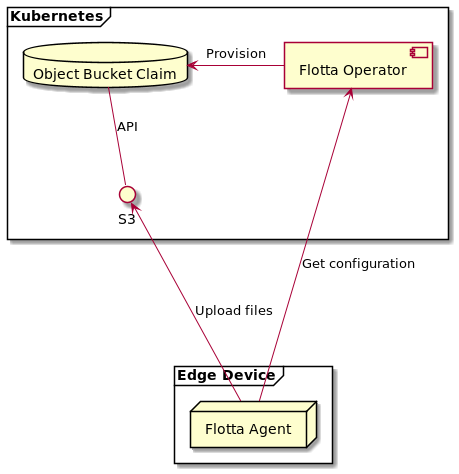-
Intro
-
Getting started
-
Operations
-
For developers
Documentation for version: v0.1.0
Data Upload
Design
Flotta agent and Operator provide functionality of uploading contents of on-device directories to control-plane object storage. User can choose between in-cluster OCS storage or external storage. OCS takes precedence over external storage. The architecture of that solution is depicted by the diagrams below.

OCS storage
Object Bucket Claim
The objects uploaded from the edge device are stored in a device-dedicated
Object Bucket Claim. Object Bucket Claim is provisioned when a device is
registered with the cluster. The OBC is created in the same namespace and with
the same name as EdgeDevice it’s created for.
S3
The Object Bucket Claim is exposed with S3 API and can be accessed with any client that supports that protocol (i.e. AWS S3 CLI and libraries).
Information needed to access the Bucket using S3 API is stored in following
resources in the same namespace as the OBC (and EdgeDevice):
- ConfigMa with the same name as the OBC contains the Bucket name and in-cluster service endpoint address;
- Secret with the same name as the OBC contains
AWS_ACCESS_KEY_IDandAWS_SECRET_ACCESS_KEY.
External S3 storage
You can use any S3 storage server for data upload. In order to configure storage for the device you need to do the following:
- configure EdgeDevice
- create storage configuration resources
Configuring EdgeDevice
The storage configuration is taken from a user supplied ConfigMap and Secret.
Both resources must be located in the same namespace as the EdgeDevice.
These resources are specified in the ‘spec.storage.s3’ section. Here’s an
example of EdgeDevice with storage configuration:
metadata:
namespace: edgedevice-namespace
spec:
requestTime: "2021-10-19T18:13:04Z",
storage:
s3:
configMapName: "s3configmap-name",
secretName: "s3secret-name",
Configuration resources
Here are examples of the resources:
ConfigMap
apiVersion: v1
kind: ConfigMap
metadata:
name: s3configmap-name
namespace: edgedevice-namespace
data:
BUCKET_HOST: play.min.io
BUCKET_NAME: device-bucket-6
BUCKET_PORT: "443"
BUCKET_REGION: us-east-1
Secret
apiVersion: v1
kind: Secret
metadata:
name: s3secret-name
namespace: edgedevice-namespace
type: Opaque
data:
AWS_ACCESS_KEY_ID: eWRheWFnaTEzNjk=
AWS_SECRET_ACCESS_KEY: eWRheWFnaTEzNjk=
tls.crt: LS0tLS1CRUdJTiBDRVJUSUZJQ0FURS0tLS0tCk1JSUZDVEND... # optional
S3 server for development and testing
You can use play.min.io as an S3 storage server.
Use minioadmin as username and password or check this
page
for the updated username (access key) and password (secret key).
The region of the bucket will probably be us-east-1.
Go to Settings for viewing and editing the region.
Get configuration
The Flotta agent periodically downloads configuration from the Flotta operator
and part of that configuration is data paths mapping for data upload - specified
in each EdgeWorkload:
spec:
data:
paths:
- source: source/path/1
target: target/path/1
- source: source/path/2
target: target/path/2
Each path specifies which on-device directory (source) should be
synchronized to which directory (target). source directory is always a
subdirectory of a “well-known” /export directory in every container running on
the device.
The /export directory is shared among containers of one workload (pod), but
different workloads (pods) have them separate; each workload has /export
directory backed by different host path volume. It is added automatically and
should not be part of the EdgeWorkload.
The device configuration provided by the Flotta operator also contains S3 connection details (endpoint URL, bucket name, keys) for connecting to a bucket.
Example
EdgeWorkload:
apiVersion: management.project-flotta.io/v1alpha1
kind: EdgeWorkload
metadata:
name: os-stats
spec:
deviceSelector:
matchLabels:
dc: home
data:
paths:
- source: stats
target: statistics
type: pod
pod:
spec:
containers:
- name: stats-collector
image: quay.io/jdzon/os-stats:v1
Pod specification used to run the workload (generated):
kind: Pod
metadata:
creationTimestamp: null
name: os-stats
spec:
containers:
- image: quay.io/jdzon/os-stats:v1
name: stats-collector
resources: {}
volumeMounts:
- mountPath: /export
name: export-os-stats
volumes:
- hostPath:
path: /var/local/yggdrasil/device/volumes/os-stats
type: DirectoryOrCreate
name: export-os-stats```
In this case on-device /export/stats directory will be synced to a
statistics subdirectory in the bucket.
Upload files
The Flotta agent synchronizes paths specified in the configuration every 15 seconds. Only new or changed files are transferred.
Files removed on the device are not removed from the storage.